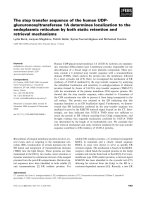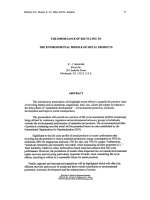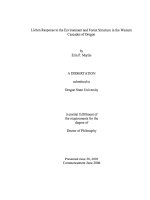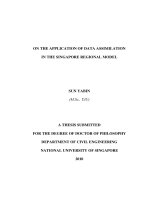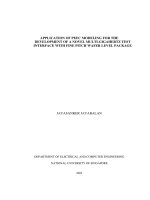Application of sense relations to teaching English vocabulary
Bạn đang xem bản rút gọn của tài liệu. Xem và tải ngay bản đầy đủ của tài liệu tại đây (352.44 KB, 9 trang )
v LANGUAGE TEACHING METHODOLOGY
APPLICATION OF SENSE RELATIONS
TO TEACHING ENGLISH VOCABULARY
NGUYEN THI HA THUONG*
*
People’s Police Academy,
Received:18/4/2019; Revised: 15/5/2019; Accepted: 17/5/2019
ABSTRACT
Vocabulary acquisition is central to language learning and of great importance to the English
Language Learners. Many learners face difficulty in correctly selecting words to deliver their
ideas due to their insufficient lexical knowledge. This work aims to analyze the significance
of sense relations instruction in vocabulary teaching. The author hopes to discuss a new path in
constructing and designing a variety of exercises and activities in sense relations in attempt to
promote learner’s English proficiency, especially vocabulary learning.
Keywords: sense relations, vocabulary teaching
1. INTRODUCTION
Vocabulary acquisition is one of the most
fundamental parts which is vital for teaching and
learning a foreign language. Without vocabulary,
there will be no development or progress made for
all the other skills such as reading comprehension,
listening comprehension, speaking, and writing.
It also plays the key roles in learners’ attempt
to utilize English. Simply, in frequently daily
activities like reading a text (in a book, newspaper,
magazine, or even manual books), listening to a
piece of music, watching English TV programs
and communicating with foreign friends via social
networks, learners will always operate with words
and widen their lexical resources.
Talking about the importance of vocabulary,
Wilkins (1972, pp.111-112) states “… while
without grammar very little can be conveyed,
38
KHOA HỌC NGOẠI NGỮ QUÂN SỰ
No. 19 (5/2019)
without vocabulary nothing can be conveyed.”
To reach the goal of expressing ideas and
forming utterance, people need to use words.
Years ago, people discovered the tremendous
importance of helping learners to develop an
extensive vocabulary. By the beginning of 1970s,
there was a major change in teaching English.
The focus turned from the Direct Method and
Audiolingualism to the Communicative Approach
which emphasized the importance of teaching
vocabulary. Language learners were exposed
to diverse vocabulary and speaking activities.
Many words began being introduced during
such courses and learners were encouraged
to express themselves as much as possible.
Words do not exist in isolation, as Taylor (1995,
p.83) explains, word meaning acquires its full
significance with reference to other related terms.
According to semantic theory, words are related to
LANGUAGE TEACHING METHODOLOGY
each other and form the massive vocabulary bank
of language. Vocabulary is an integrated system
of lexemes interrelated in sense. The meaning of
a word does not exist inside the word itself but
spreads over the neighboring words and they have
mutual affection when being combined. Then, the
meaning of a certain word can only be precisely
described through its semantic relations with other
words. In real teaching and learning experience,
remembering words from lists that are semantically
related is more effective than from lists of words
with no lexical relations. So, it is natural to state
that a teaching method which takes account of
the psychological process underlying semantic
relatedness can be more pedagogically successful.
2. REVIEW OF THEORY AND RELATED
LITERATURE
2.1. Vocabulary learning and teaching
There were many different definitions of a ‘word’,
but Nation (2001, p.27) proposes three significant
aspects which include form, meaning and use.
More specifically, form can be spoken form,
written form and word parts. Meaning of a word
is the literal meaning, its concepts or referents,
and it associations. And, the use of a word refers
to the grammatical functions, collocations, and
constraints. According to Jackson & Amvela
(2000), the vocabulary of a language is essentially
a dynamic and well-integrated system of
lexemes structured by relationships of meaning.
Arranging vocabulary into semantic cluster of
seven to ten related items rather than presenting
a list of unrelated words in isolation will enhance
retention. Normally, if a word is separated from its
environment and context, it will take the learners
a longer time to remember. Once the learners
associate the words with their topic or context, it
becomes more effective to enlarge their vocabulary
bank. Then, grouping words do helps acquire new
vocabularies.
v
As Sadoski (2005) proposes there are two
main sources of meaningful vocabulary learning:
incidental learning from context and direct
vocabulary instruction. Generally, incidental
learning refers to “learning without intent to
learn” (Lyster, 2007, p.27). Direct vocabulary
instruction refers to systematic demonstration
of ways to determine the meanings of unknown
words. Semantic maps that connect a key concept
with related events and ideas are excellent ways to
determine the background knowledge of learners
and to organize this knowledge in a way that
connects what they know to the new concepts
and vocabulary they will be learning. Effective
learning will occur when a deeper level of semantic
processing is required on the part of the learners.
Schmitt (2008) agrees that learners have higher
chances for long-term retention when they have more
opportunities to engage with new unknown word.
The learners’ lexical resources do have a
direct effect on their development of linguistic
competence. Therefore, a great importance is
put on vocabulary teaching in language teaching
procedure so that the language learners are
provided with sufficient knowledge about words.
In a language class, vocabulary is an extremely
complex process which covers many aspects listing
as semantic, lexcial, syntactic, and phonology.
Once the learners master vocabulary, they will
utilize language in their work and study. Then, the
in-depth comprehension of semantics theory can
enable them to master words, gain an insight into
the implication lexcial and collocation relations
of the words systems, enhance their ability of
forming their own language structure and promote
their competence of communication.
2.2. Sense relations
According to Mathews (1997), sense relations
refer to any relation between lexical units
within the semantic system of a language.
The lexical structure of a language can be seen
KHOA HỌC NGOẠI NGỮ QUÂN SỰ
No. 19 (5/2019)
39
v LANGUAGE TEACHING METHODOLOGY
as a network of sense relations, affected by the
members of the lexicon. Then, there does exist
a relation in meaning between lexical units of
a language. And, it is clearly that words cannot
be defined independently of other words that are
semantically related to them and delimit their
sense. As Kreidler (1998) explains, meaning of a
word depends on its associations with other and
it is relational aspect that is taken in to account.
Sense relation is a paradigmatic relation between
words or predicates, it refers to “the knowledge
of how lexemes are associated with other
lexemes” Kreidler (1998, p.48). There are two
big groups of sense relations: synonymic groups
and antonymic groups. While the first type deals
with sameness, the second type is contrastive. And
Cruse (2004) classifies sense relations into two
classes: the first entails exclusion and opposition,
the second entails inclusion and identity.
2.2.1. Sense Relations of Inclusion and Identity
The discussion in this part includes the notions of
synonymy, homonymy, polysemy, and hyponymy.
Synonymy
Nguyễn Hoà (2004, p.72) defines synonyms
as “words of the same parts of speech which have
similar meaning, but not identical meanings.”
Synonyms are phonetically and morphologically
different words belonging to same part of speech,
possessing similar denotation but differing in
connotation, combinability. Home and house can
sometimes replace each other but they differ in terms
of connotation. On the other hand, misfortune and
accident are synonyms and different in denotation.
Take a look at these following sentences:
- My house is very big/large.
- He presented firm/strong ideas in the meeting.
In these examples, the two pairs are partial
synonyms because all their meanings are not
identical. In the first sentence big and large are
40
KHOA HỌC NGOẠI NGỮ QUÂN SỰ
No. 19 (5/2019)
semantically equivalent and they can be used
interchangeably. Similarly, the second pair firm
and strong share the same feature. However,
there are clearly not synonymous in all of their
meanings, as in the following pairs of sentences:
Pair (1):
- Pollution is a big environmental problem in
Vietnam.
- Pollution is a large environmental problem
in Vietnam.
Pair (2):
- There was a strong wind last night.
- There was a firm wind last night.
Big and large, strong and firm are similar
in meaning only under specific distributional
and although all four sentences above are
grammatically well-formed, the second ones are
collocationally unacceptable.
Homonymy
Kreidler (1998, p.58) states “two ore more
forms that are identical in speech but have different
meanings are homonyms”. A homonym is a word
that is written and/or pronounced the same way
as another, but has a different meaning such as:
tail/tale or two/too/to. Homonyms can create
ambiguity, as Nguyễn Hoà (2004, p.68) points,
“homonym refers to a situation where different
words happens accidentally to have the same
forms”. A word or sentence is ambiguous if it can
be understood or interpreted in more than one way.
Take the following sentence as an example: “She
used to bawl every night.” – it can be paraphrased
in two different ways:
- She used to shout angrily every night.
- She used to weep noisily every night.
Then, actually there are 2 different “bawl”:
bawl in the first sentence and bawl in the second
LANGUAGE TEACHING METHODOLOGY
sentence are homonyms. They are written in the
same way and share the same way of pronunciation,
but they denote two different actions. Another
example of homonyms is found in the following
pair of sentences:
- John Beauchamp de Holt was the first British
baron in 1378.
- Rupert Murdoch is an old-fashioned press
baron.
The first and second baron are homonyms. They
are spelled and pronounced in the same way but
convey different meanings. The first baron refers
“a member of the lowest order of British nobility,
minor royalty”, whereas the second baron refers to
“a powerful person in business or industry”. It is
sometimes confusing to differentiate homonymy
from polysemy because the later also deals with a
pair of words which share the same way of spelling
and pronouncing.
Polysemy
Richards and Schmidt (2002, p.406) introduces
the definition of polysemy as “word having two
or more closely related meanings.” Sometimes it
is confusing to differentiate between homonymy
and polysemy. A polysemy is a word that has many
different but related meanings while homonyms
(homonyms proper) are words that have completely
different meanings. Take the following sentences
as example:
- Charles is a good actor. Many people love
him and his films.
- Mr. Brown is a very good man. He donated a
lot of money to the charity.
The word good in the two sentences above
is a polysemy with the meaning “skillful” in the
first sentence and “kind” in the second sentence.
The meanings of good in the above examples
are related to each other. Another example of
polysemy can be found in:
v
- Vietnam is rich in natural resources.
- Qatar is a rich country with a per capita
income of $123,930.
Then, the distinction between homonymy and
polysemy deals with the closeness or relatedness
of the senses between words; in other words, they
are different from each other regarding semantic
relatedness. While homonymy deals with different
meanings, polysemy deals with related meanings.
Hyponymy
According to Nguyễn Hoà (2004, p.122)
hyponym is “the member whose intentional
meaning is specific enough to cover the meaning
of the superordinate whereas the superordinate
member is the one whose extensional meaning
is broad enough to cover the hyponym.” For
example, a “rose” is a flower, but not every flower
is a rose. The meaning of “flower” is included in
the meaning of “rose”. Simply, hyponymy can be
understood as a relationship between two words,
in which the meaning of one of the words includes
the meaning of the other word. There are many
other cases such as: cat and animal, pigeon and
bird, orchid and flower. Cat is said to be a hyponym
of animal, pigeon a hyponym of bird, and orchid
a hyponym of flower. On the other hand, animal is
said to be the superordinate (also called hypernym)
of cat, bird the superordinate of pigeon, and flower
the superordinate of orchid. Such relation is often
described as one of inclusion.
2.2.2. Sense Relations of Exclusion and Opposition
The relations of senses between words can be
seen from their oppositeness or that the sense of
a word is excluded from the sense of another. The
discussion includes antonymy.
Antonymy
Kreidler (1998, p.10) defines “two words
that make opposite statements about the same
KHOA HỌC NGOẠI NGỮ QUÂN SỰ
No. 19 (5/2019)
41
v LANGUAGE TEACHING METHODOLOGY
subject are antonyms”. Basically, antonymy is the
phenomenon in which the words have the sense
relation which involves the oppositeness. Kreidler
(1998, p.100) clarifies that “Antonyms may be
nouns like Communist and non-Communist or
verbs such as advance and retreat, but antonymous
pairs of adjectives are especially numerous.”
Many words, especially those denoting
concrete objects have no antonyms. Usually,
adjectives denoting quality, verbs denoting actions
or states and abstract nouns have antonyms; take
these following pairs as examples:
ugly - pretty
mean - generous
tidy - messy
give - take
joy - sorrow
old - young
If a pair of words is antonyms, they belong
to the same semantic field, nearly identical in
distribution, such as “big – small” – both these two
words are adjective and they are about size.
In many pairs of antonyms, one is marked and
the other is unmarked. For example, when asking
some one’s height, the question to be formed is
“How tall is he?” and it is incorrect to say “How
short is he?” There are several pairs listing as:
heavy - light
deep - shallow
thick - thin
wide - narrow
There are four types of antonyms according to
John Lyon’s classification.
Antonyms proper: Antonyms proper are easily
gradable, based on the operation of gradation.
They are opposite ends of a continuous scale of
values like: hot - warm - cool – cold.
Complementary antonyms: This type of
antonym involves two items: the assertion of one
is the negation of the other. Binary antonyms come
in pairs and between them exhaust all relevant
possibilities. If one is applicable, then the other
can’t be, and vice versa. These pairs: alive – dead
and awake – asleep are typical examples.
42
KHOA HỌC NGOẠI NGỮ QUÂN SỰ
No. 19 (5/2019)
Conversives: Conversives denote the same
situation but from different points of view, with
a reversal of the order of participants and their
roles; for examples: borrow – lend, sell – buy,
employer – employee, interviewer – interviewee
and examiner – examinee.
Directional: This type of antonyms present
opposite directions of motion such as come – go
and arrive – depart.
2.3. Sense relations awareness
Sense relations are one of important elements with
regard to learning semantics, the study of language
meaning. The sense of a word can be understood
from its similarity with other words, on the other
hand, it can also be learned from its oppositeness
with other words.
Sense relations show the relationship between
words and their meanings. According to the meaning
we can differentiate between two distinctions: the
first is the “reference” which shows the external
meaning of a word (what the word refers to in the
physical world), while the other is the “sense”
that indicates the internal meaning of a word (its
content). Sense relations can indicate many kinds
of relations such as sameness or oppositeness (as
discussed in the previous part).
Lexical relations can be discussed from
paradigmatic and syntagmatic point of view which
deals with meaning in different directions, these
relations are being used to describe words or
collocations; the mutual expectancy of words or the
ability of word to predict the likelihood of another
word occurring. These relations are relevant to
each other. They overlap with each other in terms
of the relationship between the meaning of the
word in the physical world and the experience of
the way it can co-occur with other words.
From the previous point of view it can be
confirmed that sense relations study the association
LANGUAGE TEACHING METHODOLOGY
between words and their relevant to each other.
Absolutely, it is never a correct concept when
stating that the idea of each word separately has
one meaning. The awareness of these relations
should be taken in consideration by the learners
because it plays an important role in the nature of
the vocabulary and shows the way of its learning.
2.4. The importance of using sense relations
in vocabulary teaching and learning
As discussed above, words cannot be defined
independently and the structure of a language can
be seen as a network of sense relations, affected
by the members of the lexicon. Lyons (1995)
proposes an analogy, a structure is like a web in
which each strand is one such relation and each
knot in the web is a different word or expression.
Then, learning a language means the leaners study
a ‘network’ or a ‘linguistic web’. Nguyễn Hoà
(2004, p.120) emphasizes, “there is no way we can
speak about structure without relation”. And there
is no way we can learn a language without forming
our own set of vocabulary with the ‘links’ among
the words.
Firstly, sense relations help learners build
a mental network of related words which helps
memorization and retrieval of lexical items, which
can improve fluency. They also represent a logical
way of organizing new vocabulary for learners,
which again in turn helps memorization. When the
process of vocabulary development is carefully
prepared, the learners become more fluent when
speaking about a specific subject. If for instance
they have studied hyponyms of ‘food’, it will be
easier for them to talk about this topic as they
will have all (or most) of the lexis they need. This
helps learners feel more confident and relaxed
when discussing about a given topic, as they know
they have studied and memorized the relevant
vocabulary. They make it possible for learners
to develop their own networks of vocabulary
relate to different fields. If learners face some
loss of words, there would possibly be a better
v
long-term retention under the guidance of sense
relation strategy. In short, applying sense relations
theory produces greater contribution to promote
vocabulary acquisition and retention than the
traditional methods.
Secondly, knowledge about sense relations
enhance learners’ understanding of words which
results in better word choices in communicating.
According to Saussure theory, a word consist of
form (written and spoken) and meaning. Knowing
a word not only means to know the from and the
meaning, but more importantly, to be able to connect
the two. Besides, when dealing with homonyms
and polysemous items, it is vital for language
users to know the concepts behind the words, to
acquire the word meanings in different situations
and to be able to produce the words in a wide range
of contexts. In other words, misinterpretation
or misuse of lexical items can be avoided.
Moreover, knowing a word also means knowing
the associations of a word which is the semantic
relationships between words listing as synonymy,
antonymy, and hyponymy. It was emphasized by
Nation (1990, p.52) that “understanding these
relations is useful for explaining the meanings of
words and for creating activities to enrich learners’
understanding of words.”
Last but not least, having a rich lexical resource
and acquiring knowledge about word meaning
bring learners a source of power and make them
become a better reader, writer and speaker; which
generally helps open a wider path to success in
school and their future work. The most handy tool,
as Pikulski and Templeton (2004) suggest, is a rich
lexical resource and skills for using the words that
language teachers can equip their learners.
There are a wide range of teaching techniques
and activities that teachers can design for
vocabulary teaching but the key point is how to
choose and employ the most suitable ones in the
teaching and learning environment. If they do not
utilize knowledge sense relations, they may fail
to give coherence to their lesson, as Gairns and
KHOA HỌC NGOẠI NGỮ QUÂN SỰ
No. 19 (5/2019)
43
v LANGUAGE TEACHING METHODOLOGY
Redman (1986, p.32) point out. Then, aspects of
lexis such as polysemy, homonymy, synonymy,
antonyms and so on should be taken in to account.
2.5. Challenges of learning sense relations
As Lehrer (1974) mentions, languages are
setting up their semantic fields in certain ways;
this fact causes obstacles and misinterpretations
in language teaching and learning. Innovative
teaching approaches are required so that language
learners can comprehend the real meanings behind
the words and being able to communicate as
fluently as possible.
The first difficulty lies in the learners’ low
motivational state in the learning process because
of the high cognitive demands in understanding
knowledge about sense relations. As Higa (1963)
finds that pairs of synonyms take longer to learn
than pairs of unrelated words; this is understandable
since learners are more likely to confuse words that
convey similar meaning than words without close
semantic relations. Later, Higa (1965) points that
the closer the semantic link between words, the
more difficult it is to learn the words in set. Another
reason causing this matter roots from the truth that
synonyms with similar meanings do not always
have the same collocates. Language learners are
likely to be confused when using pairs as strongpowerful, firm-strong, big-large as analyzed in
the previous part. From my observation of several
years working with multiple-level of language
learners, it seems to be impossible to teach young
learners (who are at primary level) about sense
relations when their knowledge of mother tongue
is even limited. It is a truth that teaching lowlevel learners to identify the types of antonyms or
recognize polysemy is uneasy because it requires a
deep understanding of semantic features.
The second problem is found in the learners’
needs in learning vocabulary as Higa (1965)
suggests that learners may lack motivation to learn
44
KHOA HỌC NGOẠI NGỮ QUÂN SỰ
No. 19 (5/2019)
two words that have similar meaning or denote
similar information, which leads to difficulty in
learning synonyms. This fact is also indicated in
studies by Tinkham (1993) and Waring (1997).
Furthermore, as Laufer (1990) states, the less
advanced learners are unlikely to learn new words
with similar meanings because they have a greater
need to learn unknown second language meanings.
Furthermore, in English For Specific or
Content and Language Integrated Learning
courses, although it is important to introduce
technical terms, there remain challenges for both
teachers and learners because it is impossible to
pair the vocabularies into antonyms or synonyms.
For example, the author has been working in a
police’s academy and English lessons may focus
on topics like: the penal code of Vietnam, mutual
legal assistance, extradition, crime investigation
and so on. It appears that grouping words or mind
mapping are the two most frequent and favorable
choices in designing activities in class.
3.
RECOMMENDATIONS
FOR
TEACHING
AND
LEARNING
VOCABULARY
In the light of obtained result it might
be appropriate to make the following
recommendations for language teachers in their
teaching techniques and methods:
Playing the role as a facilitator, a guider and
a supporter, teachers should always keep in mind
that their teaching targets should be directed to
increase the learners’ collocational competence
with the vocabulary they have already got. Then,
they should raise learners’ awareness of sense
relations in vocabulary acquisition, knowledge
about words families should be taught in language
classes. Second languages learners should be
guided to learn vocabulary by grouping words in
different types of semantic field (lexical sets) such
as: similar meaning, opposites, derivatives, idioms
or multi words, verbs, inclusion and so on.
LANGUAGE TEACHING METHODOLOGY
Because learners should realize that the
meaning they first learnt for a word may not
be the one that it has in a new context, they
need encouragement in guessing the meaning
through the context. For example, when dealing
with a reading text with a variety of unknown
words, teachers should increase learners’ stock
of vocabulary by using the word relations like
antonyms and synonyms. The teachers should
guide them to guess the meaning of new words
from the context. Besides, it is important for
teachers to remind the learners not to use source
like dictionary as the first tool to look up for any
word. Enough exercises should be provided in the
section of “antonymy” and “relational opposites”
for the learners to make the correct use of them as
well as to differentiate between them. Knowledge
about part or speech should also be highlighted so
that the learners are directed to generate different
words. Furthermore, materials found in authentic
dialogues or daily conversations, TV programs
should be taken into use not only to enhance
listening skill but also promote the learners’ ability
in guessing the words through spoken text.
When working with learners at low levels,
teachers can use visual aids to teach vocabulary
to make the process easier. For instance, when
teaching adjectives, teachers should generally
give learners a set of adjectives with pictures to
represent them. Once they have matched the
adjectives to the pictures, teachers give them
the antonyms and ask them to match them with
their opposites; this also helps build a long-term
memory. Besides, it is also possible to teach lexical
sets or hyponyms together. In particularly, labeling
exercise can be adopted; for instance, teachers
illustrate by giving a picture (e.g. of a house) with
blank labels and a set of words (e.g. rooms and
parts of a house) and ask them to label the items.
This is generally very effective and helps learners
memorize words more easily with visual images.
At more advanced levels, teachers can draw
learners’ attention to homonyms and polysemy
when encountering them in exercises or texts. If
v
possible, we can represent the different meanings
with pictures or drawings. If that is not possible,
we can try giving at least 2-3 examples for each
item, to help learners grasp the differences in
nuance (for polysemous words) or in meaning (for
homonyms). A more likely way to get words lists
that match learners’ desires and needs is to have
the learners make their own lists from materials
they use. It is certain that learners will learn the
vocabulary of fields that interest them.
4. CONCLUSION
Basically, knowing a word involves being
able to recognize its sound, its spelling and to
distinguish it from a word with a similar form.
Knowing a word is also about the ability to
produce it, to use it in grammatical pattern along
with the word it usually collocates with and to
use it in a suitable situation using the word to
stand for the meaning it represents. Clearly, sense
relations are good descriptive devices helping with
the compilation of dictionaries and thesauri, as
source for the development of vocabulary learning
and of large-scale databases of words for use in
various applications. Therefore, understanding
and applying knowledge of sense relations in
enhancing lexical resources can benefit both
teachers and learners in teaching and learning
English. In order to improve learner’s language
proficiency, it is advised to equip them an
adequate bank of vocabularies and create chances
to promote suitable responds in communication.
Grasping well lexical resources can enable people
to successfully deliver their messages without
causing any ambiguity or misunderstanding./.
References:
Kreidler, C. W. (1998). Introducing English Semantics. London:
Routledge.
Cruse, D.A. (1995). Lexical Semantics. Cambridge:
Cambridge University Press.
Gairns, R. and Redman, S. (1989). Working With Words: A
Guide to Teaching and Learning Vocabulary. Cambridge:
Cambridge University Press.
KHOA HỌC NGOẠI NGỮ QUÂN SỰ
No. 19 (5/2019)
45
v LANGUAGE TEACHING METHODOLOGY
Higa, M. (1963). Interference effects of intralist words
relationship in verbal learning. Journal of Verbal learning
and Verbal Behavior, 2, 170-175.
Higa, M. (1965). The psycholinguistic concept of “difficulty” and
the teaching of foreign language vocabulary. Language
learning, 15, 167-179.
Nguyễn Hoà (2004). Understanding English Semantics. NXB
Đại học Quốc gia Hà Nội.
Nation, I. S. P. (1990). Teaching and learning vocabulary.
Boston, Mass: Newbury House.
Nation, P. (2001). Learning vocabulary in another language.
Cambridge: Cambridge University Press.
Pikulski, J.J. and Templeton, S. (2004). Teaching and
Developing Vocabulary. Litho in U.S.A: Houghton Mifflin
Company.
Jackson, H., & Amvela, E. (2000). Words, Meaning and
Vocabulary. Trowbridge: The Cromwell Press.
Richards, J.C. & R. Schmidt. (2002). Longman Dictionary of
Language Teaching and Applied Linguistics. 3rd ed.
London: Pearson Education Limited.
Kearns, K. (2001). Modern linguistics series-semantics, United
States of America: Macmillan.
Sadoski, M. (2005). A dual coding view of vocabulary
learning. Reading & Writing Quarterly, 21 (3), 221-238.
Laufer, B. (1990). Words you know: How they affect the words
you learn, In J.Fisiak (Ed.) Further insights into contrastive
linguistics. Amsterdam: John Benjamins.
Saussure, F.de (1996). Course in General Linguistics. New
York: McGraw- Hill Book Company.
Lehrer, A. (1974). Semantic Fields and Lexical Structure. NorthHolland linguistic series, 11. Amsterdam:North-Holland;
New York: American Elsevier.
Lyons, J. (1995). Linguistic Semantics: An introduction. London:
CUP.
Lyster, R. (2007). Learning and teaching languages through
content: A counterbalanced approach. Amsterdam/
Philadelphia: John Benjamins.
Mathews, N. (1997). A introduction. USA: Texas: Honston
Headache Clinic.
Schmitt, N. (2008). Instructed second language vocabulary
learning. Language Teaching Research, 12 (3), 329-363.
Taylor, J. R. (1995). Linguistic Categorization. Oxford:
Clarendon Press.
Tinkham, T. (1993). The effect of semantic clustering on the
learning of second language vocabulary. System, 21, 371380.
Waring, R. (1997). The negative effects of learning words in
semantics sets: A replication, System, 25, 261-274.
Wilkins, D. (1972). Linguistics in language teaching. London:
Arnold.
ỨNG DỤNG LÝ THUYẾT VỀ MỐI QUAN HỆ NGỮ NGHĨA
TRONG GIẢNG DẠY TỪ VỰNG TIẾNG ANH
NGUYỄN THỊ HÀ THƯƠNG
Tóm tắt: Việc học từ vựng là vô cùng quan trọng trong quá trình học ngôn ngữ đặc biệt là với
người học tiếng Anh. Nhiều sinh viên gặp khó khăn trong việc chọn đúng từ ngữ để diễn đạt ý
tưởng của mình do kiến thức từ vựng chưa đầy đủ. Bài viết này nhằm phân tích tầm quan trọng
của việc ứng dụng lý thuyết về mối quan hệ ngữ nghĩa trong giảng dạy từ vựng. Tác giả hy vọng
đề xuất một số giải pháp mới trong xây dựng và thiết kế nhiều bài tập và hoạt động trong ứng
dụng lý thuyết về quan hệ ngữ nghĩa nhằm nâng cao năng lực tiếng Anh của người học, đặc biệt
là học từ vựng.
Từ khoá: quan hệ ngữ nghĩa, giảng dạy từ vựng
Ngày nhận bài: 18/4/2019; ngày sửa chữa: 15/5/2019; ngày duyệt đăng: 17/5/2019
46
KHOA HỌC NGOẠI NGỮ QUÂN SỰ
No. 19 (5/2019)

